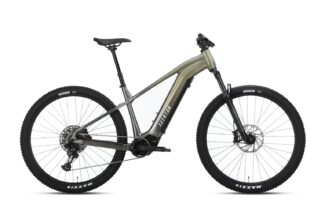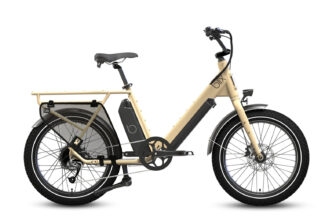Aventon Level.2 Commuter Review Overview
Targeted at commuters, the Aventon Level.2 — available in step-through (tested) and step-over frame styles at an MSRP of $1,799 — is Aventon’s first torque-sensing e-bike. Until Level.2’s introduction in 2022, the Southern California e-bike brand had exclusively used cadence sensors with its rear-hub motors.
The difference between cadence vs. torque sensing e-bikes? Cadence sensors detect if the rider is pedaling.Torque sensors, on the other hand, detect how hard the rider is pedaling. The result is that pedal assist from torque-sensing systems feels more natural and comes on with little delay, while cadence-based systems can lag in both their initial activation and cutoff. So the Level.2 represents a new level of sophistication for Aventon when it comes to pedal assist.
The Perks of the Level.2
The Level.2 also has a thumb throttle for pedal-free assist, and the drive system comes set to 20 mph for both throttle and pedal assist, making it a Class 2 e-bike. However, customers can use Aventon’s smartphone app to increase the Level.2’s pedal assist up to as much as 28 mph, which makes it an out-of-class e-bike as long as the throttle remains on the bike.

Getting the bike up to those max speeds is a 500-watt rear-hub motor (peaking at 750 watts). The motor offers five levels of pedal assist and is powered by a 672-watt-hour lithium-ion battery housed in the spacious downtube of the low-stepover aluminum frame. Riders may remove the battery with a provided key and it can be charged either on or off the bike.
Our testing yielded a battery range of 42 miles with max pedal assist increased to 28 mph and using mostly the strongest two of the five pedal-assist modes the system offers, rarely employing the thumb throttle. Charge time from zero to 100 percent is just under five hours.

Per the Level.2’s commuter intent, Aventon outfits the e-bike with metal front and rear fenders, a robust rear rack capable of carrying up to 55 pounds, a headlight, and tail lights and brake lighting integrated into the rear of the frame as well as the rear fender.
Cushioning rough pavement and potholes are a Zoom suspension fork with 65mm of coil-sprung travel, a wide and generously padded comfort saddle, and 2.1-inch-wide Arisun hybrid tires with reflective sidewalls and a water-shedding tread pattern.

The bike’s front cockpit includes 680mm-wide riser handlebars bookended with lock-on rubber grips, the e-bike system’s controller and thumb throttle on left side of the bars, and a and backlit LCD display screen with large readout perched centrally above the handlebar stem. Riders can shift among eight gears via Shimano’s Acera drivetrain, while a pair of Tektro hydraulic disc brakes keep the Level.2’s speed in check. The brakes include cutoff sensors to stop the motor from powering the bike when the levers are pulled.
Takeaways from our Aventon Level.2 Review
Muscle under the hood
Paired with Level.2’s torque sensing, the rear-hub motor accelerates quickly from a stop, without the extended delay you’ll get with a cadence-based system. That off-the-line acceleration can be enhanced by also thumbing the throttle while pedaling.
If you’re going to be riding in motor traffic, tuning the bike’s pedal assist up to the 28 mph is a no-brainer, allowing the rider to keep or exceed the pace of their fellow commuters stuck behind the wheel in urban riding environments. The speed adjustment is super simple once the bike is paired with the mobile application.
Tackling grades into the low teens without coming close to breaking a sweat is no problem for the bike in the second and third levels of pedal assist. The throttle alone will also get the job done, but starts to flirt with its limits on these steeper ascents. You’ll also see battery level drop off precipitously by relying solely on the throttle for extending climbing.
Extended range
Even with upping the bike’s pedal assist to full whack and leaning heavily on the top two assist levels, we still got very respectable range from the Level.2 — more than enough to handle most commutes.
For round-trip commutes or recreational rides pushing out beyond 40 or so miles, just toggle down to a lower assist level and stay from the battery-draining throttle. And mind the battery level on the display screen: You will not be happy slogging along on this 50-plus-pound beast and fighting its inherent motor drag should you run out of bars.
Solid component choices
Aventon strikes an admirable balance between price and performance with the eight-speed Shimano Acera drivetrain, which shifted crisply and consistently stayed in gear without any bothersome skipping. Tektro’s hydraulic disc brakes are always a welcome — so are the brand’s mechanical stoppers, for that matter, but we’ll take the hydros given our druthers. They have a smooth lever feel and offer fine modulation and strong stopping power without being overly grabby.

And the Zoom suspension fork does a commendable job smoothing out rough surfaces. Many e-bike at or below this price level will have a sprung fork stuck on more for appearance’s sake than legitimate performance. That’s not the case here; the fork does its job, and well.
Sleek integration
The original Level (the one preceding the point.2 designation) was Aventon’s first ebike with an integrated battery. That clean integration continues here and now exists throughout the brand’s entire line. It’s so much sharper and cleaner looking than the bolt-on power packs found on Aventon’s early e-bikes.The battery is also better protected from the elements.
Similarly, the rear lighting and brake lighting integrated into the frame is slick and is now seen on almost every bike in the Aventon lineup. The headlight bolts into the faceplate of the stem, so it’s also nicely integrated to alway throw its beam from the dead center of the bike.
Circuit Test
We performed the Circuit Test on a 0.75-mile loop with 65 feet of total elevation gain and loss.
| Lap # | PA Level | Avg. Speed |
|---|---|---|
| #1 | 1 | 15.6 mph |
| #2 | 2 | 17.9 mph |
| #3 | 3 | 20.7 mph |
| #4 | 4 | 21.9 mph |
| #5 | 5 (max) | 22.7 mph |
Hill Climb
We performed our Hill Climb assessment on a 0.2-mile route with 108 feet of elevation gain, a 9.7 percent average grade.
| Attempt # | Time | Avg. Speed |
|---|---|---|
| #1: Throttle only, no pedaling | 1:03 | 12 mph |
| #2: PAS 5, max pedal assist | 0:40 | 18.8 mph |
Braking Test
We performed the Braking Test from a maximum assisted speed of 28 mph on a flat paved surface.
| Attempt # | Stopping Distance (ft) |
|---|---|
| #1 | 57′ |
| #2 | 56′ |
| #3 | 54′ |
| #4 | 55′ |
| #5 | 55′ |
Reasons to Buy
Riders can customize the Level.2 to their specific needs. It comes stock as a Class 2 e-bike, but if your chosen route or bike path is limited to Class 1s, simply remove the throttle.
The 20 mph top speed too fast for you? Pair the bike with Aventon’s smartphone app and you can tune the max assist even lower if you like. Conversely, speed demons can go ahead and turn it all the way up to 28 mph just as easily.
It’s a commuter-ready rig with no immediate need for add-ons except some bags to fit to the rear rack. Or maybe you want to put a phone mount on the handlebars, perhaps a cup holder for your morning java? Aftermarket options abound (Aventon also sells several brands’ bags and a full complement of other accessories on its website). But lights? You’re already covered. Fenders? Those too — and they’re a solid set, with no pesky rattling even when rough, weathered pavement can’t be avoided.
Things to Consider
It’s a heavy bike — no two ways about it. It could be a bit much for the smallest-statured and lightest riders to manage, even with Aventon’s recommended fit range down to 4-foot-11 for the smallest frame.
Apartment dwellers will also be challenged to carry the Level.2 up stairs, if needed — not only due to its 62-pound weight, but because the low-step frame doesn’t leave a convenient place to lift the load from like a step-over frame does. It’s an awkward, unwieldy package in this regard.
As nice as the integrated battery and lighting are, untidy cable and wire management throughout the bike doesn’t help it in the looks department. This is especially so at the handlebars: Stuff is clipped together or looped securely in place, but it’s still like a spilled bowl of spaghetti out front.
We’d also like to see some protection for the bar cables, wires and rear brake hose protruding from under the frame’s bottom bracket, lest they get damaged by kicked-up road debris.


















